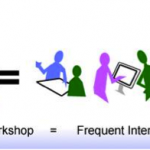What do Prototypes Prototype?
Stephanie Houde and Charles Hill
Apple Computer, Inc.
Cupertino, CA, USA
s.houde@ix.netcom.com, hillc@ix.netcom.com
A Prototype of design is that we put draft, idea, layout and other considerations outlined in this stage, so that communication between the developer and user become more related. It is essential for developer to understand what exactly they design. As a result, prototype becomes crucial in this step to benefit developer for a faster feedback, correcting misunderstanding and improvement.
Designer should know where they are going. At the beginning, it might take several steps to build one prototype. One has to put thoughts and organized them. As the article suggests, we should build multiple prototypes, know your audience and understand details of the prototype. Although I find it hard to understand how to measure the position in the triangle, the diagram in the paragraph clearly describes a relationship between implementation, role and appearance. It is brilliant to categorize types of prototype. I remembered I have read a book before describing a simple idea of the category.
The first one is low precision prototype. This types prototype can help evaluate multiple design concepts and user’s demand. It can be simple as a pencil drawing on blank paper. When building multiple prototype to understand user’s demand. There are also some disadvantages for designer to consider. A less accuracy prototype has less specific details, which will affect user experience and limit the function of prototype.
The other type of prototype can be high accuracy prototype. It is suppose to be produced as a similar final product. Since it is designed near the final result, designer can get test data that is close to the final project. We can also learn how users think in order to improve and marketing option. Finally, we can check the feedback and then getting back to see if the first expectation of the design is correct. The disadvantage of high accuracy prototype is high cost in time.
I think both methods have their own merits. There are several ways to present a prototype. Whether it is a static graphic to present a design or a film to show the interactive mode, prototype is required to present a solid definition including who are going to use, what it will be use, and a clear purpose.
————————————-
Experiencing prototype
Reference:
Sense Perception and Reality
By Rochelle Forrester
Published in 2002
http://homepages.paradise.net.nz/rochelle.f/Sense-Perception-and-Reality.html
Through the article, now I learn more about prototype. At first, I think prototype as a component or model for a product. In fact, it’s more than that. Learning experience is much more complicated because it’s a dynamic, complex and subjective phenomenon. What we need to consider first is that how exactly we perceive the world in a manner when we can understand and to respond.
In a paper by Rochelle Forrester (2002) Sense Perception and Reality,
“Our method of knowing about the world is primarily and perhaps exclusively through out sensory apparatus… This information, widely called sensations, lets us know the colour and shape of things… They allow us to be aware of certain qualities of the things in the world. There appears to be no way in which we can find out about the world external to ourselves, other than through our sensory apparatus.”
Through this paragraph we can view user experience as a response to our “sensor” so that we understand outside world and response accordingly. If we want to design a natural interaction mode, these sensors, as a result, will be viewed as important apparatus and be applied in possible manner. For instance, Nintendo’s Wii is a turning point in changing publics experience in playing video games. It certainly provides interesting experience and better interaction. There is also a similar example, the digital camera interaction architecture prototype, in the article. In another example is the role-playing experiment, what really value experience prototype is people always reflect in different manner. That is humanity: to change from the norm.
Experience prototypes should give clear direction to both designer and user.It is easier if shared experience can reflect personal life, that experience will be easy to understand when communicate. Experience prototype in this case, give us a better scope to understand that. It will greatly benefit to both designer and user if we understand the characteristic of user.
————————————-
Cardboard Computers
Reference:
Significance of Participatory Design in Offshore Software
Development Scenario
Design Research / Article 4.
Feb. 2008, HCI Vistas Vol-IV
Author: Atul Manohar
Source: http://www.hceye.org/UsabilityInsights/?p=88
Mock-ups, as article described, can be most useful in early stages of the design process. They encourage user’s active involvement so that user can feel more being accepted in the design progress.
With cardboard mock-ups it’s simple: the purpose is design, and the mock-ups are used to evaluate a design, to get ideas for modifications or maybe even radical new designs. Cardboard mock-ups provide a medium for collaborative changes.
We already discuss how experience can affect interaction. According to article, one of the reasons for the effectiveness of cardboard mockups is that user can enjoy the interaction process directly. Through this process, we can evaluate a design, to get ideas for modifications or maybe even radical new designs. More importantly, to have a medium for collaborative changes.
Source: http://www.hceye.org/UsabilityInsights/?p=88
While reading the article, I do not fully understand the meaning of Utopia project, so I try to look somewhere else. And I do find an article explaining participatory design which I think might help. We can see that through participatory design, we can have a better vision of simplified designing process instead of long discussion without conclusion. We must understand that interaction incorporate participant here. However, as the article mention, one of the hardest challenges for designer seems to be to create a design language that can communicate with the participant. I think that’s reason he mentions hands-on experiences and ready-to-hand usage. What we can achieve with cardboard is make a prototype more like a final product.


Comments!